A Deep Dive into Amerishade Grass Seed Benefits
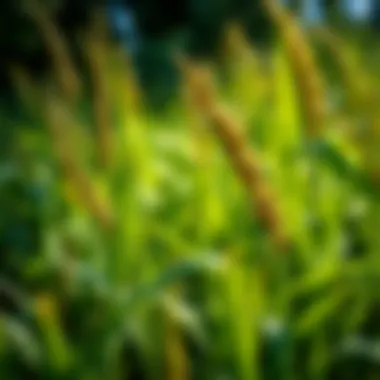
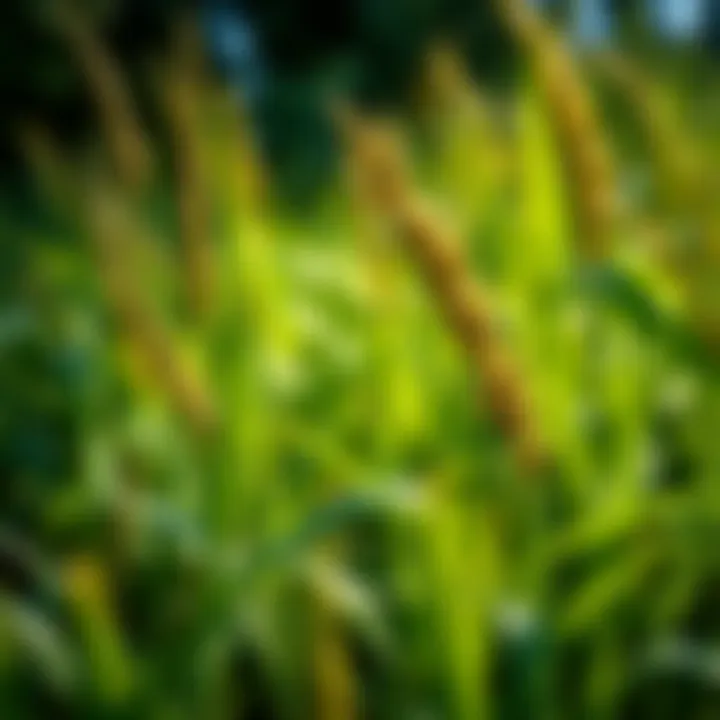
Intro
Amerishade grass seed is gaining recognition as a versatile solution for gardeners and landscapers grappling with the challenges of shaded environments. This innovative grass mix not only thrives in less-than-ideal lighting conditions but also suits a variety of soil types, making it a go-to choice for transforming dim spaces into verdant oases.
Often neglected, shaded areas in yards can drastically impact the overall aesthetics and utility of outdoor spaces. From providing a cozy gathering spot under trees to enhancing the curb appeal of homes, addressing shade issues is vital. Amerishade grass seed comes as a boon for those wishing to maximize their green space's potential.
In this guide, we'll explore the key attributes, optimal conditions for growth, and the manifold advantages that Amerishade grass seed brings to the table. Moreover, we will tackle the obstacles one might encounter during its cultivation and offer strategies to circumvent these hurdles. Whether you're a budding gardener or a seasoned expert, you'll find ample insights tailored to meet your needs.
Prolusion to Amerishade Grass Seed
In the realm of landscaping and turf management, Amerishade Grass Seed stands out as a remarkable solution, especially for those dealing with less-than-ideal sunlight conditions. Its emergence is not merely a trend but a response to the growing needs of gardeners and landscape architects seeking robust options for shaded areas. From city parks to private backyards, Amerishade is becoming a staple, addressing one of the biggest challenges faced by green thumbs - growing thriving plants in the shade.
Definition and Importance
At its core, Amerishade Grass Seed is a specially formulated blend designed to thrive in low-light environments, where traditional grass varieties often falter. This innovative seed mix caters to a variety of grass species that are naturally adapted to shaded conditions, providing a lush and green appearance where it once seemed impossible. Importantly, the significance of Amerishade stretches far beyond aesthetics; it plays a crucial role in promoting biodiversity and enhancing urban green spaces.
Understanding the role of Amerishade Grass Seed is key for both hobbyists and professionals alike. It offers a myriad of benefits, including reduced maintenance costs and water conservation, while supporting local wildlife. For instance, having a healthy, shaded lawn helps mitigate surface runoff, promoting soil health and sustainability.
“A garden is a reflection of the care and consideration we give to our environment; Amerishade helps nurture that relationship.”
Background and Development
The journey of Amerishade Grass Seed began with a simple observation: conventional grass types often withered and struggled under the dense canopy of trees found in many landscapes. Researchers and agronomists took note of this challenge in the 2000s, and thus began the focused effort to develop a seed mix tailored for such conditions.
This seed blend integrates species like fine fescues, Kentucky bluegrass, and perennial ryegrass, each contributing unique characteristics that complement the other. Fine fescues, for instance, are particularly suited for shady areas, boasting fine textures and adaptability to varied soil conditions. Over the years, trials conducted in various environments have led to the refinement of Amerishade’s formula, optimizing it for performance in both residential and municipal applications.
The feedback from early adopters and ongoing research fueled further enhancements. The goal was clear: to create a product that not only performed well but also contributed positively to the ecosystem. As a result, Amerishade Grass Seed has evolved into a sustainable choice for gardeners, aligning with modern ecological practices.
As we delve deeper into the specifics of Amerishade’s botanical characteristics, ideal growing conditions, and the numerous benefits it offers, the foundational understanding outlined in this section sets the stage for informed decision-making about this exceptional grass seed.
Botanical Characteristics
Understanding the botanical characteristics of Amerishade grass seed is essential for any gardener, whether you're a seasoned pro or dipping your toes into the world of landscaping. These traits define how the grass seed interacts with its environment, its suitability for specific conditions, and ultimately how well it will thrive in your yard.
Species Composition
Amerishade grass seed is a blend largely consisting of fescue species, particularly tall fescue and fine fescue. This combination provides a unique advantage, as it harnesses the strengths of both types. Tall fescue boasts deep roots and robust drought resistance, while fine fescue offers finer textures and superior shade tolerance.
The inclusion of multiple species assures a resilient grass mixture. Depending on the climatic and soil conditions of your region, the seed composition can be adjusted to optimize growth potential. It's not just a question of aesthetics; the right blend can make the difference between a thriving lawn and a patchy yard.
For instance, a lawn primarily in the shade can benefit more from fine fescue than from other grass types, which may struggle due to insufficient sunlight. The careful selection of species highlights the adaptability of Amerishade grass to various environments.
Growth Habits
The growth habits of Amerishade grass seed reflect its ecological versatility. Generally, this grass grows upright and dense, establishing a lush lawn that can withstand heavy foot traffic. One notable aspect is how quickly it emerges after planting. Unlike some slower germinating varieties, Amerishade tends to sprout within seven to twelve days, depending on soil temperature.
This prompt establishment is key for homeowners looking to achieve immediate results. Additionally, the grass reaches a height between 3 to 4 inches, which offers an aesthetically pleasing lawn without the need for excessive mowing. Deep rooting is another positive trait; Amerishade can reach deeper soil layers for nutrients and moisture, fostering a healthier plant overall.
On a more practical note, the grass adapts well under various mowing heights. If you tend to keep your lawn longer, the Amerishade can handle it without wilting. Conversely, those who prefer a tidy, closely cropped look will find it responds well to regular trimming.
“The adaptability of Amerishade grass seed makes it a serious contender for anyone seeking a sustainable, low-maintenance lawn.”
By understanding these characteristics, gardeners can better plan their landscapes, ultimately fostering a vibrant green space that endures season after season. Learning about the composition and growth habits also helps in diagnosing potential issues and planning appropriate care strategies.
Ideal Growing Conditions
Establishing Amerishade grass seed successfully hinges on understanding the ideal growing conditions. It’s not solely about tossing seeds onto soil and hoping for the best; the nuances involved can either make or break your efforts in cultivating vibrant green spaces. Knowing the soil requirements, light exposure needs, and watering habits can significantly improve your chances of achieving a lush, healthy lawn, especially in shaded areas.
Soil Requirements
Soil serves as the foundation of any successful gardening project. For Amerishade grass seed, soil texture and pH level are particularly crucial. This grass variety thrives in well-draining soil that retains moisture without becoming waterlogged. You’ll want to aim for a loamy texture—think of it as a cozy bed for seeds, with enough aeration to breathe. To create the right conditions, consider enriching poor-quality soil with organic matter. Materials like compost or well-rotted manure can make a world of difference.
Additionally, the pH should generally be between 6.0 and 7.0, slightly acidic to neutral. Too acidic or alkaline soil can hinder grass development, leaving it vulnerable to pests and diseases. A simple soil test kit can help you nail down the current pH levels. If you’re looking to adjust the pH, lime can raise it, while sulfur can bring it down.
Light Exposure
Amerishade grass seed gets its name because it performs exceptionally well in shaded environments. Yet, not all shade is created equal. The amount of light your lawn receives throughout the day will greatly impact the overall growth and health of the grass. Ideally, Amerishade requires indirect sunlight—full sun would be a bit much for it, like putting a vampire in the middle of a sunny beach. On the flip side, if your space is extremely dark with little light filtering through, that could hamper growth as well.
Optimal areas are those that receive dappled sunlight, with some breaks in the canopy allowing sporadic sunlight to hit the ground. Take note of how much light your area receives at various times; a simple observation can guide you to make the right decisions:
- 1-3 hours of light: Considered low shade; Amerishade can handle it.
- 4-6 hours of light: Ideal for robust growth.
- No direct sunlight: Check other grass options or improve light access.
Watering Needs
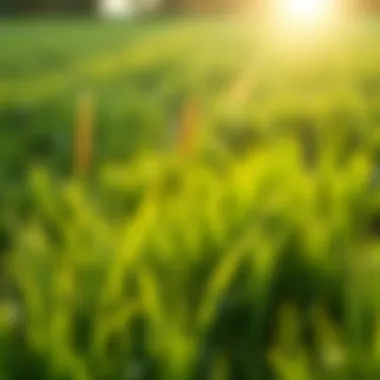
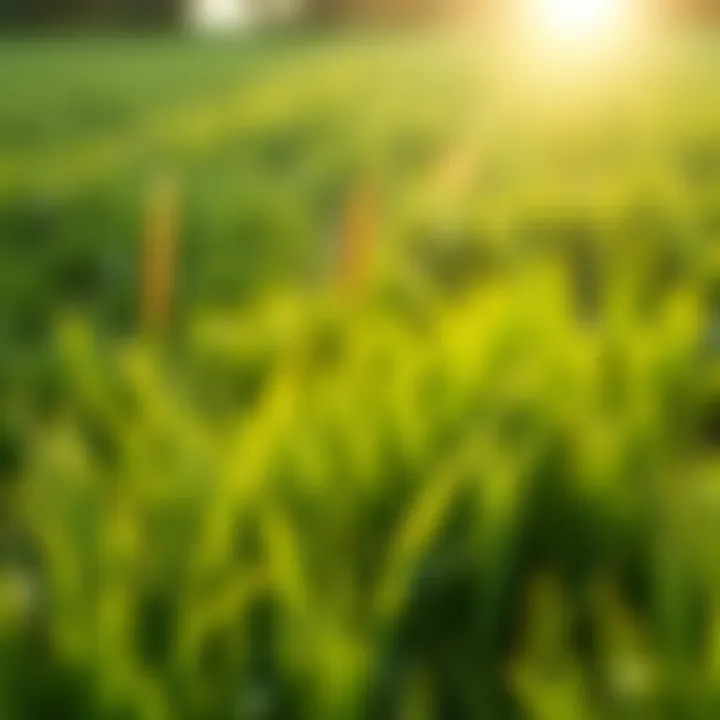
Watering practices directly correlate with the health of any seedling, and Amerishade grass is no exception. To achieve the lush lawn you’re dreaming of, establish a consistent watering routine. When first seeding, keep the soil consistently moist but not overly drenched. Watering should be done early in the morning to minimize evaporation and ensure that roots can absorb the moisture throughout the day.
Generally, aim for about 1 to 1.5 inches of water per week, factoring in rainfall. During dry spells, you might need to ramp up watering frequency or duration. A good indicator for whether your lawn needs watering is the “footprint test.” If your footprints linger after walking on the lawn, it’s time to give it a drink.
"A little consistent care in the beginning can lead to a flourishing lawn in the end."
Understanding the ideal growing conditions tailored for Amerishade grass seed is not just a matter of following instructions; it’s about cultivating an environment for growth, just as the grass itself requires care and consideration. Taking the time to prepare soil properly, ensuring it receives the right amount of light, and establishing a careful watering schedule pays off in the long run, leading to robust, verdant landscapes.
For more details on soil testing and preparation, check out resources such as USDA.gov and University of Florida IFAS Extension for a scholarly approach to soil management.
By committing to these conditions, you can enhance the vitality of your Amerishade lawn, allowing it to thrive even in areas where other grass varieties might struggle.
Benefits of Using Amerishade Grass Seed
Amerishade grass seed is not just any old seed; it's a lifeline for those dealing with tricky shaded areas in their lawns and gardens. In an age where environmental considerations are paramount, understanding the benefits of this grass seed becomes essential for gardeners who want thriving green spaces. They say you can’t fight nature, but with Amerishade, you can certainly work with it.
Shade Tolerance
One of the standout features of Amerishade grass seed is its impressive shade tolerance. Traditional grass varieties often get sunburned—or they just up and quit in shady spots. However, Amerishade is engineered to thrive even when the midday sun takes a holiday. This characteristic stems from its unique blend of fine fescue and other grass species, allowing it to flourish under the canopy of trees or in areas that receive dappled sunlight.
- Reduces Maintenance Needs: Less time spent mowing and watering means more time to enjoy your landscape.
- Increases Usable Space: Previously neglected areas can transform into vibrant parts of your garden or yard.
When planting Amerishade, gardeners can weave in the natural patterns of their surroundings. It's like giving a second lease of life to those dim patches where little else could survive.
Environmental Resilience
In today's world, resilience is key, and Amerishade grass seed doesn’t just survive; it thrives in various environmental conditions. This seed is tough and ready to face the elements without breaking a sweat. Whether it’s torrential rain or dry spells, Amerishade exhibits remarkable adaptability.
Benefits related to environmental resilience include:
- Drought Resistance: Amerishade holds onto moisture, making it less thirsty than ordinary grass types.
- Disease Resistance: Formulated for robustness, it is less susceptible to common lawn diseases.
- Eco-Friendliness: This seed typically requires fewer chemicals, which means a healthier environment for your plants, wildlife, and even your family.
Utilizing Amerishade grass seed encourages practices of sustainability in landscaping, which is increasingly vital in our changing climate.
Aesthetic Appeal
Aesthetics can make or break a landscape, and Amerishade doesn't disappoint in the beauty department. With its lush green foliage and fine texture, it creates inviting spaces that catch the eye and warm the heart. This grass seed doesn’t just provide a cover; it enhances the visual interest of your outdoor areas.
Here are a few more notes on its aesthetic appeal:
- Seasonal Color Changes: Amerishade maintains its rich hue throughout the seasons, so your garden remains lively even during colder months.
- Fine Blades: The delicate texture creates a soft appearance, making it ideal for residential lawns and parklands alike.
- Versatile Uses: Whether you aim to create a shady oasis for relaxation or a vibrant playground for kids, Amerishade fits the bill seamlessly.
Establishing Amerishade Grass Seed
Establishing Amerishade grass seed is a fundamental step that shapes the health and appearance of a landscape, especially in areas where sunlight struggles to penetrate. Getting this right is not just about planting seeds; it's about creating a thriving ecosystem that can withstand the rigors of shade environments. Understanding the nuances of this process empowers gardeners and farmers alike to make informed decisions, turning their shaded spaces into robust green areas.
Site Preparation Techniques
Before sowing Amerishade grass seed, a well-prepared site is crucial. This involves several steps aimed at setting a solid foundation.
First, remove any debris—fallen branches, stones, or old grass. Such obstacles can hinder growth and promote disease. You’d be surprised how effective simply clearing the area can be.
Next, evaluate the soil quality. Test the pH level if possible; Amerishade prefers a slightly acidic to neutral range (around 6.0-7.0). If your soil is too acidic, consider amending it with lime, while sulfur can help in high pH scenarios.
Once the soil is ready, loosen it up using a rake or tiller. This step enhances aeration and drainage, which are crucial for germination. Finally, a light layer of organic matter, such as compost, can improve soil fertility and structure, making it much more favorable for the seeds to take root.
Seeding Methods and Timing
Timing and technique go hand in hand when it comes to planting Amerishade grass seed. The ideal time for sowing is in early spring or late summer when temperatures are mild. This ensures that the seeds have the best chance to germinate and establish roots before extreme weather kicks in.
As for methods, broadcasting the seed uniformly across the prepared site ensures density. A seeder can make this job easier, allowing for a more consistent distribution.
Consider these methods when planting:
- Broadcast seeding: This is the most common method, where seeds are spread over the soil surface.
- Drill seeding: If precision is a must for your project, using a seed drill to ensure even spacing might be preferred.
After sowing, lightly rake the surface to cover the seeds with a thin layer of soil. This prevents them from washing away and protects them from birds, which can be quite the nuisance.
Post-Planting Maintenance
Once your Amerishade grass is planted, the key to success lies in adequate maintenance. First, watering becomes pivotal. Initially, the soil should remain consistently moist but not soggy. Using a fine mist or light spray can prevent displacing seeds that have not yet settled.
Additionally, be alert for any competing weeds; they can choke your fledgling grass. A light mulch layer can help in suppressing weeds while retaining moisture. If using fertilizer, a slow-release type applied according to soil recommendations can promote healthy growth without shocking the newly planted seeds.
A well-tended lawn begins its life with nurturing. Little efforts during these early days can lead to lush greenery in the upcoming years.
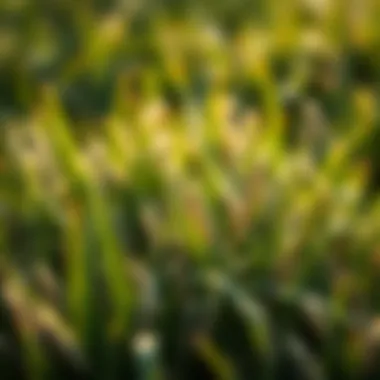
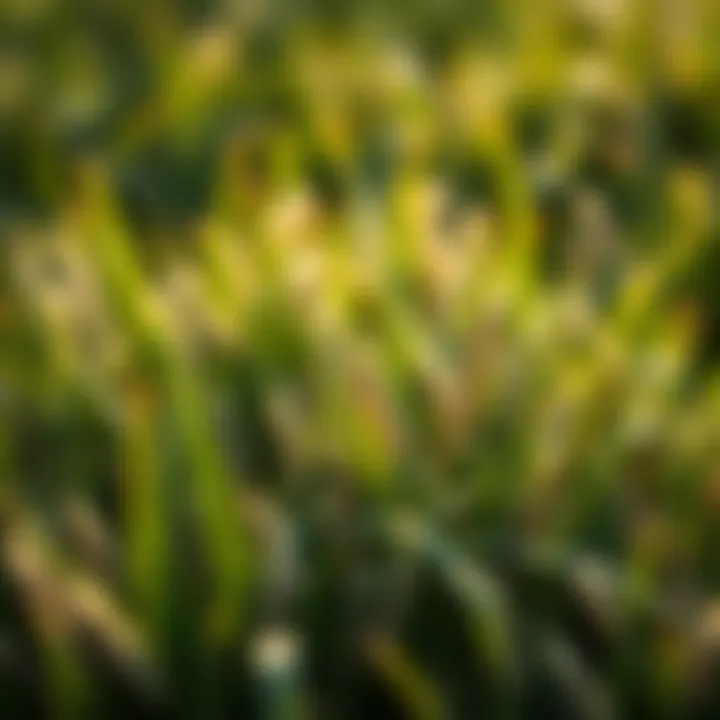
In summary, establishing Amerishade grass seed involves thorough preparation, smart planting techniques, and diligent maintenance. By attending to these factors, the transformation of shaded corners into vibrant green landscapes is not just a possibility, but an achievable reality.
Troubleshooting Common Issues
When growing Amerishade grass seed, understanding common issues is crucial for ensuring a healthy lawn. No seed is immune to challenges, but knowing how to tackle them can mean the difference between a thriving green space and one that's struggling to survive. This section discusses two notable concerns: pests and diseases, along with nutrient deficiencies. By being equipped with knowledge, gardeners can respond proactively and maintain the beauty of their landscapes.
Pests and Diseases
Pests and diseases can wreak havoc on your Amerishade grass. These adversities not only hinder growth but can also impact the aesthetics of your lawn.
- Common Pests:
- Identifying Symptoms:
- Management Strategies:
- White Grubs: These larvae feast on grass roots, leading to patches of dead grass. Look for birds or animal activity, as these often indicate an infestation.
- Chinch Bugs: Small but mighty, these insects suck moisture from the grass, resulting in browning of the turf.
- Fungus Gnats: If you notice small flies around your lawn, these pests might be weakening your grass by causing root rot.
- Yellow patches, thinning grass, or increased weed presence could suggest pest issues.
- Spotting unusual growths or discolorations hints at underlying disease, such as brown patch or dollar spot.
- Regularly inspect your lawn. Catching problems early simplifies resolution.
- Utilize organic insecticides or beneficial nematodes to control pests naturally.
- Maintaining proper drainage prevents fungal diseases. Consider aerating your lawn to improve airflow.
"Prevention is worth a pound of cure." Taking timely action makes all the difference in keeping pests at bay.
Nutrient Deficiencies
Nutrient deficiencies can undermine the vigor of your Amerishade grass. Nutrients such as nitrogen, phosphorus, and potassium play vital roles in growth and resilience.
- Signs of Deficiency:
- Diagnosing the Problem:
- Addressing Deficiencies:
- Nitrogen Deficiency: Look for yellowing of older leaves. This symptom often presents as a lack of vigor during the growing season.
- Phosphorus Deficiency: Stunted growth and dark bluish-green coloration can mean your grass is lacking phosphorus.
- Potassium Deficiency: Browning leaf edges and poor drought resistance are typical alarms.
- Conduct a soil test to determine nutrient levels. Most local extension offices provide testing services.
- Visually inspect grass health, noting any patterns or widespread issues that arise.
- Incorporate a balanced fertilizer to restore the necessary nutrients. Select blends tailored for shaded areas, as they consider the unique growth habits of Amerishade grass.
- Organic amendments such as compost or manure enhance soil quality over time, supporting healthier grass growth.
By understanding these common issues and their solutions, gardeners can alleviate potential setbacks with Amerishade grass. Timely intervention ensures that your lawn remains lush and vibrant, embodying the beauty of well-cared-for green spaces.
Long-Term Management Strategies
Managing Amerishade grass seed effectively extends beyond just establishment and short-term care. It's about implementing practices that support sustainable growth and health of the grass over time. The significance of long-term management lies in maximizing the seed’s benefits while ensuring to maintain the landscape's aesthetic and ecological balance. Key elements include appropriate fertilization, proper irrigation, and mindful lawn care practices that align with the unique demands of this resilient grass type.
Fertilization Practices
Proper fertilization is fundamental in maintaining the vigor of Amerishade grass. Knowing when and how to fertilize can make all the difference. It's not just about throwing down some fertilizer whenever you feel like it. Timing and type matter.
- Soil Testing: Before applying any fertilizer, conduct a soil test. This will provide insight into nutrient levels and pH. The goal is to create an environment where the grass thrives.
- Slow-Release Fertilizers: These are often preferred because they provide nutrients over an extended period. It means the grass gets what it needs without the risk of burning its roots. Look for formulations with balanced nitrogen, phosphorus, and potassium ratios.
- Seasonal Application: The main fertilization can occur in early spring as grass begins to grow. A second round in late summer can prepare it for the cooler months. Lively growth in the early period leads to stronger rooting.
"The secret to a lush lawn is not how much you fertilize, but how well you understand your lawn's needs."
Irrigation and Water Management
Effective water management is essential for the sustainability of Amerishade grass in any landscape design. It’s easy to drown the plant with water or, conversely, let it dry out too much. Proper practices will aid in supporting the health of your lawn and can save both time and resources.
- Watering Schedule: The best rule of thumb is to water deeply but infrequently. Early mornings, just after dawn, are ideal times for watering, as this minimizes evaporation.
- Moisture Monitoring: Use a soil moisture meter to avoid over or under-watering. Amerishade does have some degree of drought resistance, but consistent moisture during peak growth will yield the best results.
- Adjusting for Seasonal Changes: As seasons change, so should your watering habits. In warmer months, expect to up the ante. Conversely, during cooler seasons, the grass requires less.
- Rainwater Harvesting: Consider investing in systems to collect rainwater. This not only reduces water costs but also provides grass with quality hydration.
Long-term management practices for Amerishade grass seed extend beyond just nurturing the grass into a lush green carpet. By applying informed fertilization routines and effective water management strategies, users can achieve persistent success in various environmental conditions.
Comparative Analysis with Other Grass Seeds
When selecting the right grass seed for varying landscapes, understanding how Amerishade grass seed stacks up against other options is crucial. This section unpacks why comparing these grass seeds matters, emphasizing the unique qualities of Amerishade that can lead to more successful outcomes in shaded areas than traditional varieties.
Advantages Over Traditional Varieties
One of the primary benefits of Amerishade grass seed is its shade tolerance. Many traditional grass species struggle to thrive in shaded environments, often leading to patchy, unattractive lawns that require frequent overseeding. In contrast, Amerishade delivers a dense and lush green appearance even under reduced sunlight conditions. Here’s a closer look at the advantages:
- Improved Resilience: Unlike fescue or bluegrass, Amerishade has been specially formulated to withstand low-light environments, reducing the likelihood of substantial lawn failure during the hotter months.
- Adaptability: Amerishade grass can adapt to a wider variety of soil types, including clay, loam, and sandy soils, giving it an edge in diverse landscapes.
- Pest Resistance: Many traditional grasses fall prey to pests, but Amerishade’s robust genetic makeup often makes it less susceptible, leading to healthier growth with reduced chemical inputs.
Overall, Amerishade’s persistent performance in challenging conditions marks it as a worthwhile contender in any gardener's seed selection.
Limitations and Considerations
While Amerishade grass seed possesses many favorable characteristics, it’s only wise to weigh these against potential drawbacks.
- Cost Considerations: Often, specialized seeds like Amerishade can carry a higher price tag compared to standard grass seeds. This can be a key factor for budget-conscious growers.
- Maintenance Needs: Although resilient, Amerishade may still require specific maintenance practices, such as regular fertilization and proper irrigation scheduling, to reach its full potential. In comparison, some traditional grass types may require less attention after establishment.
- Climate Adaptability: While Amerishade shows promise in shaded areas, its performance can waver in extreme climates. Growers in regions with harsh winters or hot summer months should ensure they have local conditions that align with Amerishade’s growth habits.
"Choosing the right grass seed is about knowing your environment. Understanding Amerishade's strengths and weaknesses in comparison to traditional types helps make informed decisions."
Thus, while Amerishade offers numerous advantages, it’s paramount to consider these limitations. By evaluating the specific growing scenarios and understanding the nuances of different options, gardeners and landscape managers can create vibrant, verdant spaces that truly reflect their intended vision.
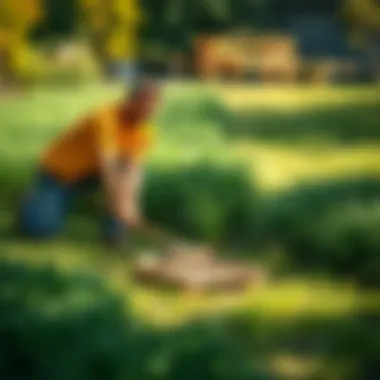
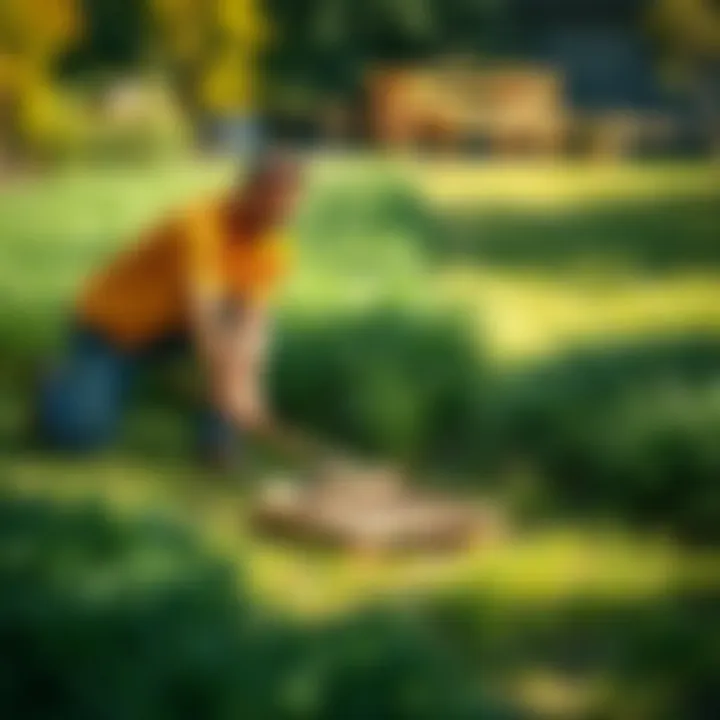
For more detailed information on the growing conditions and specific comparisons, consider checking resources such as Wikipedia or agricultural websites like University of Kentucky.
Engaging with community forums like Reddit can also provide valuable insights from fellow gardeners and enthusiasts.
Case Studies and Success Stories
In the realm of sustainable landscaping, the role of Amerishade grass seed has become more pronounced due to its unique ability to thrive in shaded conditions. Case studies and success stories serve as vital narratives that not only highlight its effectiveness but also provide practical insights for implementation. Examining these examples can inspire confidence and empower both novice and seasoned gardeners to utilize Amerishade grass seed in their own projects.
By analyzing various applications, we can glean lessons on best practices and common hurdles. Importantly, these stories reveal how Amerishade grass seed adapts to various environments, making it an excellent choice for diverse landscapes. The following sections will delve into two significant avenues of application: municipal uses and residential landscaping.
Municipal Applications
Municipalities are often faced with the challenge of creating green spaces that can endure various environmental stresses while still offering aesthetic and functional value. In one notable case, a city faced significant shade challenges due to extensive tree canopies in public park areas. This led to limited turf growth and unsightly patches of bare ground.
To address this, city planners opted for Amerishade grass seed, knowing its shade tolerance would align with their goals.
By thoroughly preparing the soil and selecting the right planting period, the municipality successfully established a lush, green area in areas previously thought unsuitable. The effects of this decision were manifold:
- Improved community engagement as residents flocked to the newly greened park
- Enhanced aesthetic value of the public spaces, encouraging more recreational use
- Reduction in maintenance costs in terms of lawns needing fewer fertilizers and water
These tangible outcomes showcased how Amerishade grass seed could transform municipal environments, ultimately contributing to a healthier ecosystem and higher quality of life for residents.
Residential Landscaping
In the private sector, homeowners have also embraced Amerishade grass seed to revitalize their shaded backyards. A recent case involved a family living in a wooded area, where traditional grass varieties continually faltered, leaving patches of soil exposed and struggling against erosion.
After transitioning to Amerishade grass seed, the family reported remarkable improvements within months.
- Lush growth took shape where there was once only bare soil, allowing for increased usage of their outdoor space.
- The resilient nature of the grass reduced the requiremment for constant watering and fertilizer, leading to lower bills.
- Moreover, the visual appeal of their yard increased, creating a flourishing oasis that attracted local wildlife.
These personal stories, alongside municipal examples, underscore the adaptability of Amerishade grass seed. They show its capability to not only beautify but also enhance ecological sustainability within various contexts.
In summary, case studies demonstrate that Amerishade grass seed is a versatile solution, ideal for both public and private settings. Whether it’s a city park struggling under shade or a homeowner seeking to maintain an attractive yard, Amerishade grass seed proves itself to be a valuable asset in modern landscaping.
Future Trends in Grass Seed Development
As we look toward the future of agronomy, understanding the trends in grass seed development becomes essential, particularly with innovations like Amerishade grass seed shaping the way we manage landscapes. This section dives into the significance of ongoing research and sustainable methods that promise to redefine our approach to grass cultivation.
Research and Innovations
Grass seed research has come a long way since the days of merely selecting hardy strains. Today, we are witnessing a wave of innovative techniques aimed at improving not only the quality of grass seed but also its adaptability to various environments. Some key developments to note include:
- Genetic Modification: Scientists are pushing the boundaries by developing genetically modified grass varieties which offer enhanced drought resistance and faster growth rates. This can be particularly beneficial for areas facing climate challenges.
- Hybridization Techniques: Continued hybridization efforts are leading to new seed strains that combine the best traits of different species. This can yield grass that not only withstands shade but also requires less water and fertilizer.
- Biotechnology: Advancements in biotechnology are enabling the creation of grass seeds that have improved disease resistance. For instance, seeds modified to resist certain fungi can provide healthier lawns with less pesticide usage.
- Smart Seed Technology: Some researchers are experimenting with seed coatings that release nutrients gradually, which supports plants’ growth over a longer period. This method can significantly reduce the frequency of fertilization, aligning with sustainable practices.
By embracing these cutting-edge innovations, farmers and landscapers can expect resilient, thriving grass in areas once deemed difficult for cultivation.
Sustainable Practices and Regenerative Agriculture
Sustainable practices in grass seed development are not just a trend; they represent an essential shift in how we approach agriculture. As more consumers demand environmentally friendly solutions, it’s vital to consider how Amerishade grass seed fits into this movement.
- Soil Health: One major emphasis is on nurturing soil health through practices such as crop rotation and cover cropping. Grass species like Amerishade can enhance soil structure and fertility, making it a valuable player in sustainable landscaping.
- Water Conservation: Techniques such as rainwater harvesting and using percolation pits are becoming commonplace. With Amerishade’s lower water requirements, farmers can cultivate lush landscapes without straining local water supplies.
- Regenerative Agriculture: This holistic approach not only focuses on sustainability but aims to restore ecosystems by enhancing biodiversity. By incorporating diverse grass seeds including Amerishade into their practices, farmers can actively contribute to healthier ecosystems while also improving their yield outcomes.
- Low-input Systems: There is a tangible shift away from high-input agriculture. Grass seed breeders are working towards varieties that thrive with are less fertilizers and pesticides, greatly benefiting the environment.
In summary, the future of grass seed development hinges on integrating innovative research and sustainable practices. As Amerishade grass seed continues to gain traction, it exemplifies how the agricultural community can evolve towards greener pastures—both literally and figuratively.
"Sustainable methods paired with innovative technology are paving the way for a new era in agriculture, ensuring that future generations inherit not just soil, but thriving ecosystems."
For further insights on grass development trends, consider exploring the resources available on websites such as Wikipedia, Britannica, and specialized agricultural forums on Reddit.
By remaining abreast of these trends, agricultural enthusiasts and professionals alike can better prepare for the challenges and opportunities that lie ahead, crafting the green landscapes of tomorrow.
Closure and Recommendations
As we wrap up our comprehensive dive into Amerishade grass seed, it's crucial to recognize the significant role it plays in both practical landscaping and environmental sustainability. This grass seed variety tackles one of the most common challenges for gardeners—shading from trees and buildings that can stifle growth for traditional grass types. Embracing Amerishade allows gardeners not only to beautify their outdoor spaces but also to contribute positively to the ecosystem.
One must consider that the success of Amerishade grass isn't solely dependent on the seed itself, but also on proper execution of the previous guidelines concerning soil quality, watering strategies, and ongoing maintenance. This is where the overarching recommendations become profoundly pertinent. A well-prepared site and an understanding of your specific environment will enhance the performance of this grass seed.
Summary of Key Points
To recap, several key insights emerged throughout our exploration:
- Shade Tolerance: Amerishade performs admirably in shaded conditions, making it a superior choice for areas that receive limited sunlight.
- Environmental Resilience: Its strong adaptability to varying climates helps in reducing maintenance efforts.
- Aesthetic Appeal: With its lush green appearance, it enriches the landscape, providing a visually appealing space that can host activities.
- Maintenance Needs: Regular monitoring for pests, irrigation adjustments, and fertilization are essential for its longevity and vitality.
Ultimately, integrating Amerishade into landscape management isn’t merely an option; it becomes a strategy aligning horticultural ambition with ecological responsibility.
Practical Guidance for Users
For farmers and gardening enthusiasts looking to optimize their use of Amerishade grass seed, here is practical guidance to consider:
- Conduct a Soil Test: Understanding your soil's pH and nutrient levels helps in tailoring amendments before planting. Knowing what you're working with simplifies the process.
- Prepare the Area: Clear out weeds and debris. This is foundational for ensuring that the Amerishade can establish itself without competing for resources.
- Follow Seeding Recommendations: Spread the seeds evenly, aiming for the specified density. This enhances the chances of robust growth.
- Water Smartly: Initial watering should be frequent and light to encourage germination, transitioning to deeper, less frequent watering once established.
- Be Patient: It may take a bit before the grass fully establishes, but timely care will pay off in vibrant green spaces that thrive.
In closing, Amerishade grass seed isn’t just about filling up space in a yard. It’s a forward-thinking solution to modern landscaping issues that reflects a commitment to sustainable practices. For further guidance, resources like Wikipedia and University of Kentucky Extension provide additional insights into best practices for grass selection and maintenance.



